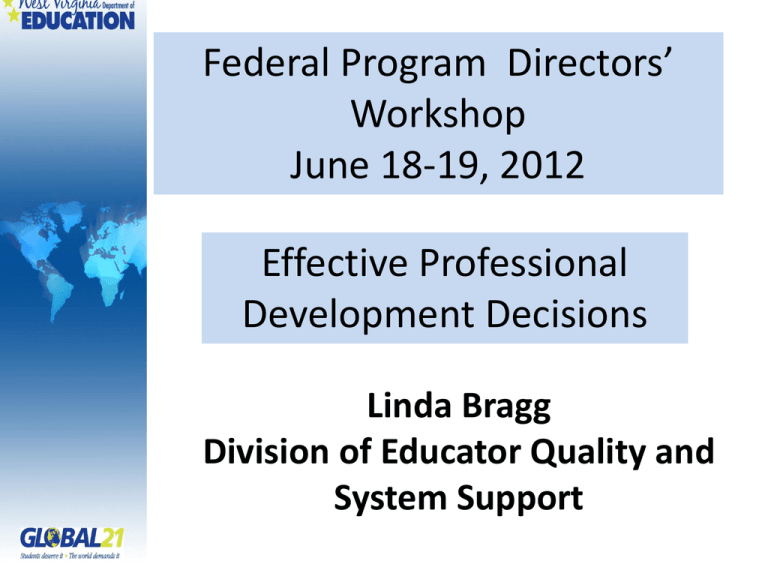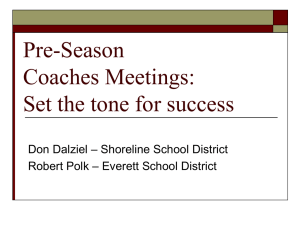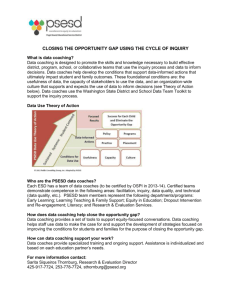Federal Program Directors’ Workshop June 18-19, 2012 Effective Professional
advertisement

Federal Program Directors’ Workshop June 18-19, 2012 Effective Professional Development Decisions Linda Bragg Division of Educator Quality and System Support Professional Development Considerations A. Finance Choices for Professional Development that Produce the Greatest Gains in School Performance & Student Learning B. Considering Effective Professional Development as Part of: 1. The District’s Continuous Improvement Plan 2. The District’s Professional Development Plan 3. The District’s Highly-Qualified Plan a. Recruiting b. Retaining c. Retraining 4. Comprehensive System of Support for Improving Professional Practice Title Program Requirements • Must be based on needs of the school district listed within the 5 year plan • Must be targeted first at schools identified for improvement • Must focus on enhancing student achievement • Must be supplemental positions and not supplant state or local funds House Bill 4236 Major Provisions 1. Establishes a new system of educator performance evaluations that is based on the current pilot 2. Provides for “phasedin” implementation 3. Requires state board rules by July 2013 4. Provides for evaluations to serve certain purposes, including plans of improvement and personnel actions 5. Provides the intent of new comprehensive system of support and requires the state board to publish guidelines on comprehensive system of support WV State Board of Education Guidelines • Expectation that the highest priority for county, regional and state professional development will be on meeting the needs indicated by the results of annual educator performance evaluations • Substantial redirection of existing professional development resources toward this highest priority • Adoption of the Learning Forward (formerly National Staff Development Council) Standards for Professional Learning 5 WV State Board of Education Comprehensive System of Support Guidelines • Utilized as the basis for the design and implementation of a comprehensive system of support for improving professional practice in each county school system (county plan) • Implementing systemic change in schools and classrooms is a long-term process that requires a significant commitment of professional development, technical assistance and continuous support 6 Considering Finance Choices for Effective Professional Development Evidence-Based Approach to: • Effective resource allocation and use (resource reallocation, if necessary) • Strategic use of human resources What Guides the Thinking to Use our Time and Money Effectively? How does your district proportion the categories that result in professional learning that increases educator effectiveness and desired results for all students? Professional Learning Categories • • • • Face-to-Face Workshops/Trainings New Teacher Induction Job-Embedded Professional Development (Peer Support) Technical Assistance for Educators (who need to improve performance) Setting the Stage for Learning and Instruction “Creating a collaborative environment has been described as ‘the single most important factor’ for successful school growth and the ‘first order of business’ for those seeking to enhance the effectiveness of their school.” DuFour & Eaker, 1998 1 Why Collaboration? “The idea that a single teacher, working alone, can know and do everything to meet the needs of 30 diverse students every day throughout the school year has rarely worked, and it certainly won’t meet the needs of learners in years to come.” Carroll, 2009 1 Collaborate About What? If we want our professional development efforts to have a significant impact on student learning, we should focus those efforts on the factors that significantly impact learning. Critical Questions of Teaching & Learning 1. What do all students need to know, understand and be able to do in this lesson or unit of study? 1.5 -- What CORE instructionPut will abest facilitate learning? slide of the the Critical questions of teaching and learning here 2. How will we know if they have learned it? 2.5 -- What evidence will we accept during the learning that indicates where each student is on the learning progression? 3. How will we respond if students do not learn? 3.5 -- What TARGETED or INTENSIVE instruction will likely have the most impact, given the evidence of student learning? 4. How will we respond when they already know it? 4.5 -- What projects or collaborative studies will likely have the most impact for enrichment or acceleration, given the evidence of student learning? 13 What Support Would You Give? How can we provide the support to ensure teams use their collaborative team time in ways that have a positive impact on student learning? Could coaching be an opportunity to Support Teaming Processes? Could coaching be an opportunity to Support Beginning Teacher Induction? Could coaching be an opportunity to build capacity of teachers to assist peers after the coach is gone? We engage in and assume leadership for promoting collaborative practice. Noted educator Roland Barth wrote, “The relationship among the adults in the building has more impact on the quality and character of the school and the accomplishments of its youngsters than any other factor.” Let’s Ponder In what ways could coaches assist teachers or teacher teams with focusing on the Critical Questions of Teaching & Learning? Would utilizing coaches to support jobembedded PD be more effective than a workshop for translating learning into practice? Number & Type of Coaches School Improvement 37 Mentor 27 Technology 89 Curriculum & Instruction 181 Curric & Instruc Technology School Improv Mentor 20 Count of Coaches By Funding Source ARRA, 3 Ed Jobs, 16 County, 48 Title II, 127 ECE, 1 IDEA, 14 Levy, 6 RLIS, 10 State, 37 ARRA County Ed Jobs ECE IDEA Levy RLIS State Step 7 Title I, 137 Step 7, 5 Title I Title II 21 Did you know that for Title Programs... • there is no limit to the amount of federal funding you may choose to spend on coaches? • coaches may count toward the mandatory requirements of 10% PD for Title I or 25% PD for Title II, Part D? 22 Categories of Coaches in West Virginia Curriculum & Instructional Work of Curriculum & Instructional Coaches 23 Categories of Coaches in West Virginia C&I Technology 24 Categories of Coaches in West Virginia C&I Technology School Improvement 25 Categories of Coaches in West Virginia C&I Technology Induction School Improvement 26 Coaching for School Growth The Work/Influence that is Common to All Coaches in West Virginia 27 Why Coaching? “Coaching facilitates learning from and with colleagues, sustained over time, where reflection, analysis, dialogue and problem-solving strategies are applied.” Kinkead, 2007 1 Effective Coaches • Create partnerships with teachers, teacher teams and principals • Establish trusting relationships • Facilitate instructional growth Kinkead, 2007 1 WVDE’s Professional Learning Structure of Support for West Virginia Coaches Task Force Recommendations for supporting coaches and mentors Policy Support (teacher induction) Strategic Professional Development Resources Supporting Improved Learning and Instruction through a Community of Practice 1 Organizational Learning Collaborative Conversations Data / Evidence Collective Commitment Psychology of Learning Student Self Efficacy IMPACTS STUDENT ACADEMIC SUCCESS Collective Efficacy Instructional Best Practices (CAI) Kids See Their Learning Is Different/Better “Student Sees Success” Instructional/Engagement Change Coaching for School Growth The Work of Coaches Supporting All Educators A. Coaching Teaming Processes (collaborative and leadership teams) B. Coaching for Professional Performance (individual educators) 1. Specific Technical Assistance for Individual Teachers 2. Induction: Mentorship and/or Coaching of Beginning Teachers Standards for Professional Development The WVBOE has adopted the Learning Forward (formerly National Staff Development Council) Standards for Professional Learning, as its guide for providing high quality professional development. According to the standards, professional learning that increases educator effectiveness and results for all students: Occurs within learning communities committed to continuous improvement, collective responsibility, and goal alignment; Requires skillful leadership to develop capacity, advocate, and create support systems for professional learning; Requires prioritizing, monitoring, and coordinating resources for educator learning; Uses a variety of sources and types of student, educator, and system data to plan, assess, and evaluate professional learning; Integrates theories, research, and models of human learning into learning designs to achieve its intended outcomes; Applies research on change and sustains support for implementation of professional learning for long-term change; and Aligns its outcomes with educator performance and student curriculum standards. Is Professional Development in your district primarily based on…. • Teacher preferences? • Grant determinants? • Various district offices’ control? Effective Professional Development • Why? • How? • What? • Peer Support Let’s Ponder Implementation “In theory there is no difference between theory and practice; in practice, there is.” variously attributed to Jan La Van De Snepscheut or Albert Einstein or Yogi Berra Transferring Professional Development Learning into Classroom Practice Component Knowledge Skill Transfer • Why? Theory 10% 5% 0% • How? Demonstration 30% 20% 0% • What? Practice 60% 60% 5% • Peer Support 95% 95% 95% Organizational Learning Collaborative Conversations Data / Evidence Collective Commitment Psychology of Learning Student Self Efficacy IMPACTS STUDENT ACADEMIC SUCCESS Collective Efficacy Instructional Best Practices (CAI) Kids See Their Learning Is Different/Better “Student Sees Success” Instructional/Engagement Change Which way will your District Leadership Team choose to support professional development? Which ways will your District Leadership Team support collaborative teaming ?





